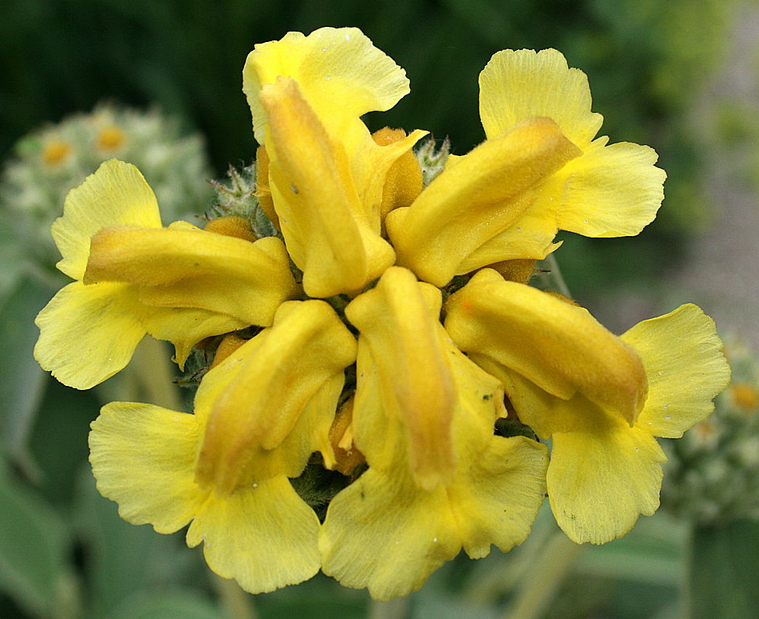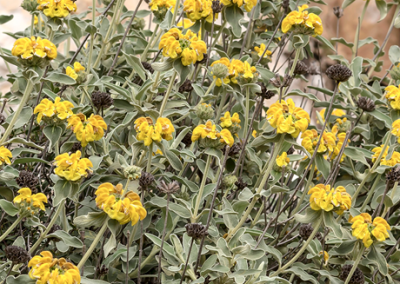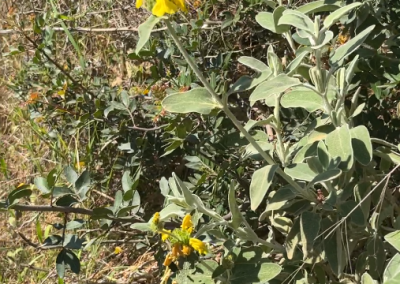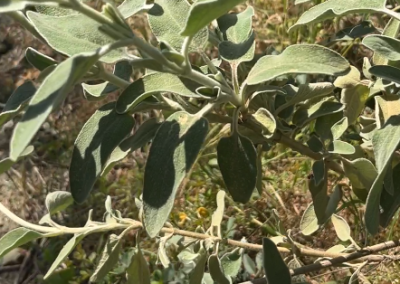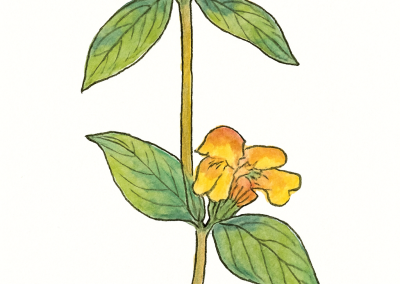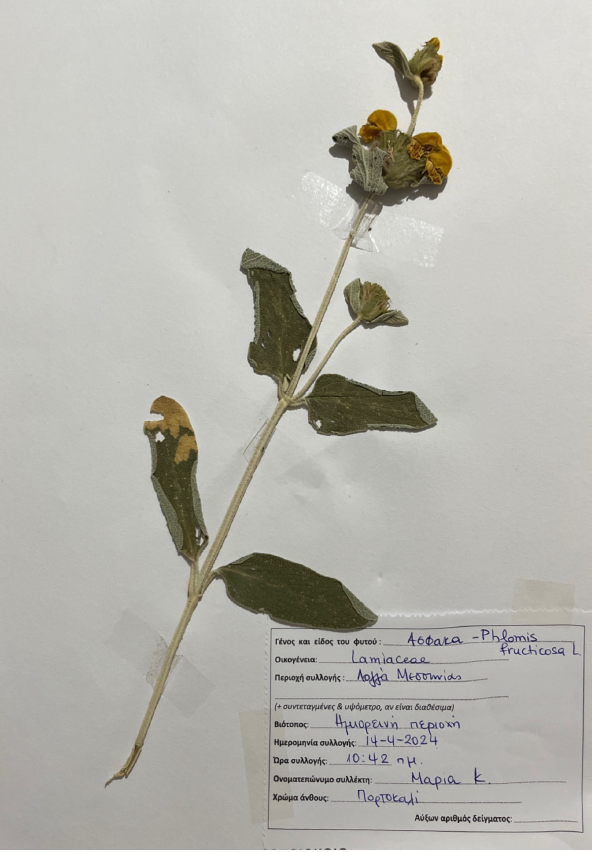Phlomis fruticosa
Scientific description
Scientific name: Phlomis fruticosa
Common name: Jerusalem Sage
Kingdom: Plantae
Phylum (Division): Tracheophyta
Class: Magnoliopsida
Order: Lamiales
Family: Lamiaceae (Mint family)
Genus: Phlomis
Species: Phlomis fruticosa L.
Origin:
Native to the eastern Mediterranean region, including Greece, Turkey, Lebanon, Israel, and southern Italy. Thrives in dry, rocky hillsides and scrubland habitats typical of the Mediterranean basin.
Description:
Small, evergreen shrub, typically 50–100 cm tall, recognized for soft, woolly, grey-green lance-shaped aromatic leaves; bright yellow hooded flowers in whorls around stems, blooming late spring to early summer; square stems typical of mint family; shrubby dense form with woody branches at base. Woolly foliage gives drought resistance and silvery visual appeal.
Propagation:
• By seed: slower germination than cuttings.
• By semi-hardwood cuttings: common, reliable, taken in summer.
• By division: mature clumps divided in spring or autumn.
Ecology:
• Very attractive to bees, especially bumblebees.
• Prefers dry, rocky, well-drained soils; found in garrigue, maquis, open woodlands.
• Thrives in full sun, tolerates poor soils; drought-tolerant once established.
• Deer-resistant, wind-tolerant, tolerates salty coastal air.
Usage:
Popular in Mediterranean-style, drought-tolerant, and wildlife-friendly gardens. Leaves historically used as herbal infusions or poultices.
Επιστημονική ονομασία: Phlomis fruticosa
Κοινή ονομασία: Φασκόμηλο
Βασίλειο: Φυτά: Plantae
Φύλο (διαίρεση): Τραχεόφυτα
Κλάση: Magnoliopsida
Τάξη: Lamiales
Οικογένεια: Lamiaceae (Οικογένεια της μέντας)
Γένος: Phlomis
Είδη: Phlomis fruticosa L.
Καταγωγή:
Ελλάδα, Τουρκία, Λίβανος, Ισραήλ και νότια Ιταλία. Ευδοκιμεί σε ξηρές, βραχώδεις βουνοπλαγιές και θαμνώνες χαρακτηριστικούς για τη Μεσόγειο.
Περιγραφή:
Μικρός, αειθαλής θάμνος, 50–100 cm ύψος. Μαλακά, μαλλιαρά, γκριζοπράσινα φύλλα σε σχήμα λόγχης, αρωματικά. Φωτεινά κίτρινα, κουκουλωτά άνθη σε σπείρες γύρω από βλαστούς, ανθίζουν τέλη άνοιξης έως αρχές καλοκαιριού. Τετράγωνοι βλαστοί, χαρακτηριστικοί της μέντας. Θαμνώδης, πυκνή μορφή με ξυλώδη κλαδιά στη βάση. Μαλλιαρή υφή φύλλων: αντοχή στην ξηρασία, ασημένια όψη στον κήπο.
Πολλαπλασιασμός:
• Με σπόρο: βλάστηση πιο αργή από μοσχεύματα.
• Με μοσχεύματα ημίσκληρου ξύλου: κοινή, αξιόπιστη, το καλοκαίρι.
• Με διαίρεση: ώριμες συστάδες άνοιξη ή φθινόπωρο.
Οικολογία:
• Πολύ ελκυστικό για μέλισσες, ιδιαίτερα βομβίνους.
• Προτιμά ξηρά, βραχώδη, καλά στραγγιζόμενα εδάφη, συχνά garrigue, maquis, ανοιχτά δάση.
• Ηλιοφάνεια, ανθεκτικό σε φτωχά εδάφη, ανθεκτικό στη ξηρασία.
• Ανθεκτικό σε ελάφια, άνεμο, αλμυρό αέρα.
Χρήση:
Δημοφιλές σε μεσογειακού τύπου, ανθεκτικούς στην ξηρασία και φιλικούς προς την άγρια ζωή κήπους. Φύλλα χρησιμοποιούνταν στο παρελθόν ως αφεψήματα ή καταπλάσματα.
Nom scientifique : Phlomis fruticosa
Nom commun : Sauge de Jérusalem
Règne : Plantae
Phylum (Division) : Tracheophyta
Classe: Magnoliopsida
Ordre: Lamiales
Famille: Lamiaceae (famille de la menthe)
Genre: Phlomis
Espèce: Phlomis fruticosa L.
Origine:
Région méditerranéenne orientale: Grèce, Turquie, Liban, Israël, sud de l’Italie. Préfère collines sèches, rocailleuses et broussailles typiques du bassin méditerranéen.
Description:
Petit arbuste persistant, 50–100 cm. Feuilles laineuses gris-vert, lanceolées, aromatiques. Fleurs jaunes en capuchon, verticillées sur tiges, floraison fin printemps-début été. Tiges carrées. Forme dense, branches ligneuses à la base. Foliage laineux: résistance sécheresse, aspect argenté.
Propagation:
• Par graines: germination plus lente que les boutures.
• Par boutures semi-ligneuses: méthode fiable, été.
• Par division: touffes matures printemps ou automne.
Écologie:
• Très attractif pour les abeilles, surtout bourdons.
• Sols secs, rocailleux, bien drainés; garrigue, maquis, forêts ouvertes.
• Soleil plein, tolère sols pauvres; tolère sécheresse.
• Résistant aux cerfs, vent et air salin côtier.
Utilisation:
Populaire en jardins méditerranéens, tolérants à la sécheresse et faune. Feuilles autrefois utilisées en infusion ou cataplasme.
Denumire științifică: Phlomis fruticosa
Denumire comună: Salvia Ierusalimului (Jerusalem Sage)
Regn: Plantae
Încrengătură: Tracheophyta
Clasă: Magnoliopsida
Ordin: Lamiales
Familie: Lamiaceae (Familia mentei)
Gen: Phlomis
Specie: Phlomis fruticosa L.
Origine:
Estul regiunii mediteraneene: Grecia, Turcia, Liban, Israel, sudul Italiei. Se dezvoltă pe versanți uscați, stâncoși și zone de vegetație mediteraneană (maquis, garriga).
Descriere:
Arbust mic, peren, veșnic verde, 50–100 cm. Frunze moi, lânate, verde-gri, lanceolate, aromatice. Flori galbene, tip glugă, dispuse în verticile, înflorire târziu primăvară–început vară. Tulpini pătrate. Formă densă, ramuri lemnoase la bază. Frunziș lânos: rezistență la secetă, aspect argintiu.
Înmulțire:
• Semințe: germinare mai lentă decât butașii.
• Butași semilemnoși: metodă eficientă, vara.
• Divizare: tufele mature, primăvară sau toamnă.
Ecologie:
• Foarte atractiv pentru albine, în special bondari.
• Soluri uscate, stâncoase, bine drenate; maquis, garriga, păduri deschise.
• Soare plin, tolerează soluri sărace; rezistent la secetă.
• Rezistent la vânt, aer sărat și neconsumat de căprioare.
Utilizare:
Popular în grădini mediteraneene, xeriscape și prietenoase cu fauna sălbatică. Frunze folosite în trecut în infuzii sau cataplasme.
Creative writing inspired by Phlomis fruticosa
Phlomis fruticosa — Asphaka
In the rugged hills of ancient Greece, there was a wise old healer named Asphaka, known for her deep connection with nature and her ability to use plants to heal both body and spirit. She lived in a small, windswept village, surrounded by rocky terrain where few plants could thrive. Yet, Asphaka's garden was lush, filled with hardy herbs and shrubs that withstood the harsh climate. Among them grew a plant with silvery leaves and soft, yellow flowers, known as Phlomis fruticosa. The villagers called it "Asphaka," after the healer, for its strength and resilience reminded them of her.
The plant had many uses—its leaves could soothe wounds, and its flowers brought relief to those with ailments. But beyond its medicinal properties, the Asphaka plant held a deeper magic, one that connected it to the gods themselves.
One day, the god Hermes, the swift messenger of Olympus, was traveling across the lands. His journey took him through the treacherous, rocky hills where the winds blew fiercely, and the sun beat down mercilessly. Exhausted and parched, Hermes stumbled upon Asphaka's garden. Intrigued by the silvery leaves glistening under the sun, he bent down to touch the plant. Instantly, a sense of calm washed over him, and his strength returned. Hermes realized that this was no ordinary plant—it carried the strength of the earth and the wisdom of those who understood its secrets.
Hermes sought out Asphaka and asked her about the plant's origin. She told him that it grew where others could not, thriving in harsh conditions because it drew strength from the earth itself. Touched by the plant's ability to survive where others failed, Hermes blessed Asphaka and her plant, ensuring that it would forever be a symbol of endurance and protection.
He decreed that those who grew Asphaka would be blessed with strength in adversity, just as the plant endured under the harshest of conditions. From that day on, the Phlomis fruticosa, or "Asphaka," became known not only for its healing properties but also for its spiritual power to protect and fortify those who nurtured it.
Over time, the villagers believed that the Asphaka plant held divine blessings, providing resilience and courage to those who cared for it. Its soft yellow flowers, glowing like the sun, were seen as a beacon of hope, even in the most difficult times. To this day, the plant remains a symbol of perseverance, reminding people that, like the Asphaka plant, they too can thrive in even the harshest conditions with strength and grace.
Thus, the myth of the Asphaka was born, intertwining the wisdom of the healer with the resilient power of the plant, a reminder that even in life’s toughest moments, there is beauty and strength to be found.


